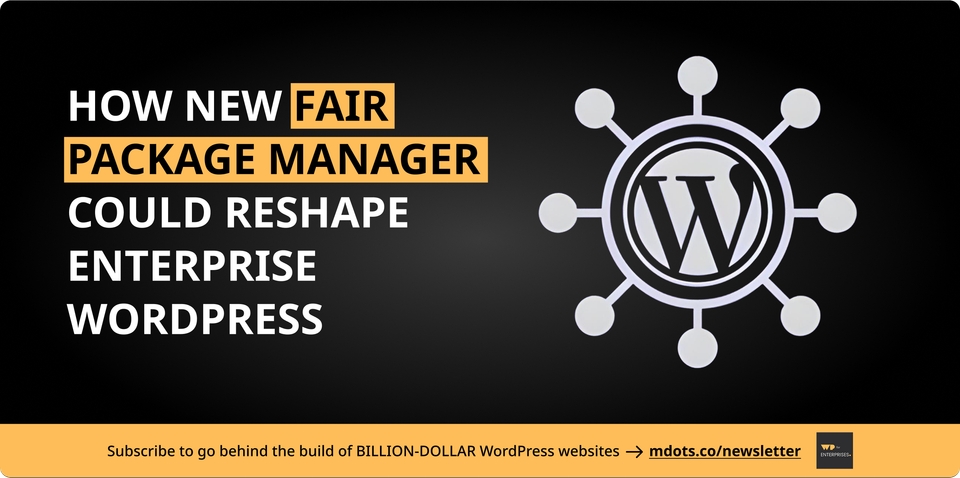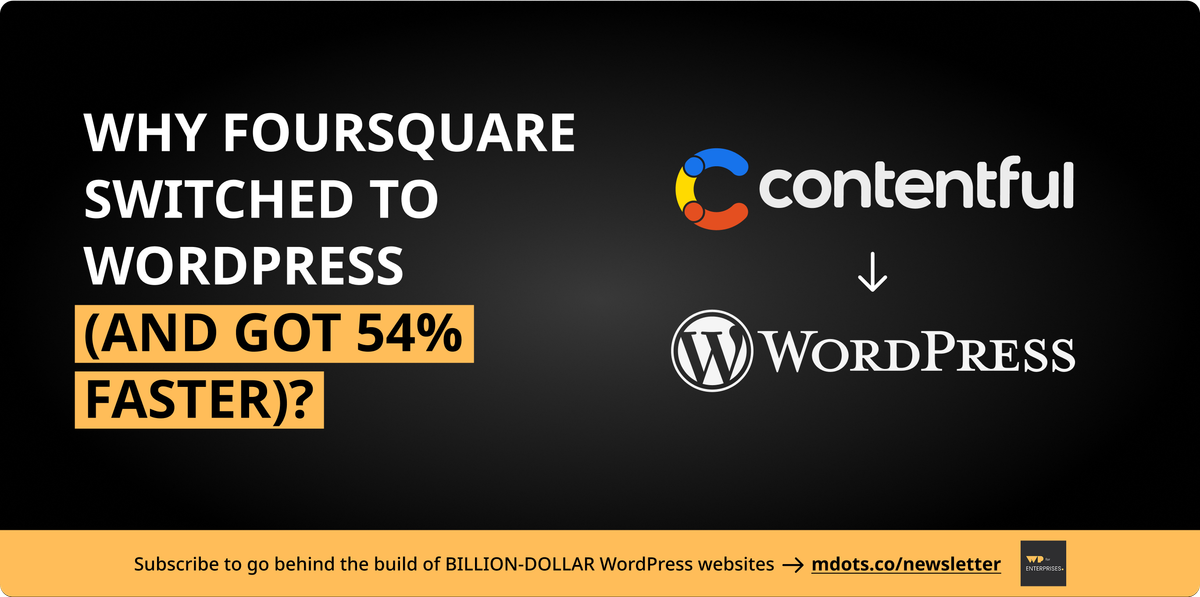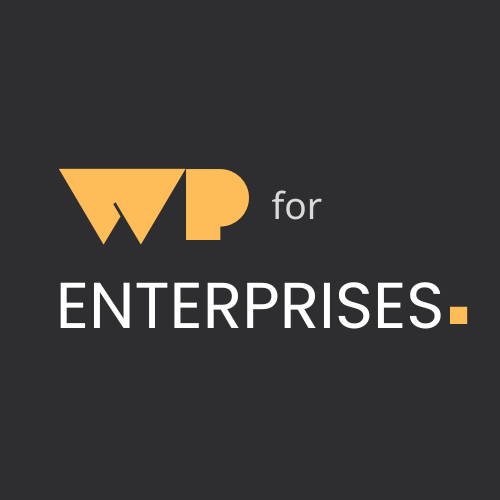WordCamp Europe 2025: Why FAIR is the Story Every Enterprise Should Watch

I made a last-minute trip to WordCamp Europe in Basel last week.
Honestly, I’m glad I did. It was great to catch up with old friends and meet many new folks in the WordPress community.
But what really stood out? There were some big, breaking stories this year.
One topic in particular dominated every hallway conversation — especially among the enterprise crowd: FAIR.
The newly launched Federated and Independent Repositories (FAIR) package manager could fundamentally change how WordPress is managed at scale.
If you’re running large, mission-critical WordPress platforms — this is one to watch closely.
Here’s what I heard, saw, and learned about FAIR — plus 4 other key highlights from Basel.
1: THE FAIR PROJECT
What is FAIR?
FAIR is an independent package manager for WordPress.
Think of it as an alternative to the official App Stores — like if someone created another app store besides Apple’s or Google’s.
It gives enterprises an alternative way to manage updates — core, plugins, themes, and translations — in a decentralized, secure, and transparent way.
In plain terms: you no longer have to rely solely on WordPress.org for updates.
How does it work?
- FAIR is installed as a plugin.
- It replaces the default update checks and pulls updates from enterprise-controlled or FAIR-governed sources.
- Enterprises can run private repositories behind firewalls.
- You can add stronger supply chain security — code signing, cryptographic checks, compatibility scanning.
Who’s behind FAIR?
- FAIR is backed by the Linux Foundation and built with contributions from across the WordPress community.
- Led by Joost de Valk (Founder of Yoast) and Karim Marucchi (CEO Crowd Favorite), who are coordinating the FAIR initiative.
- Backed by senior core contributors, including many with over 15 years of experience contributing to WordPress.
Why was FAIR created?
Remember that fight last year between Automattic and WP Engine?
It started when WordPress.org took over the slug of the Advanced Custom Fields (ACF) plugin — which WP Engine owned.
This triggered a lot of concern among enterprise users and WordPress community.
Karim Marucchi, summed it up:
"That incident forced legal teams to ask: Why should we trust a system where one person could flip a switch? FAIR is about creating structural trust and transparency."
Pros for Big Enterprises:
- Not a fork of WordPress itself — more like a fork of WordPress.org infrastructure (alternative update source).
- Backed by the Linux Foundation, which adds credibility and neutral governance.
- More control over updates and asset sourcing.
- Ability to run curated private repositories behind firewalls.
- Stronger supply chain security.
- Better alignment with GDPR and CRA requirements.
- More resilience — less reliance on a single update server.
- For large enterprises that need full control over plugins, themes, and source code updates — FAIR is an interesting option to watch.
Cons / Trade-offs:
- Right now, FAIR is mostly a mirror of WordPress.org, but future FAIR-native apps could introduce confusion around trusted sources.
- Could divide community spirit instead of uniting it — something to keep in mind.
- Increases complexity — more infrastructure to manage.
- Increases the attack surface — as Matt Mullenweg said: “more potential points of compromise”.
- Could impact phased rollouts and telemetry — FAIR bypasses some of the centralized data WordPress core teams use.
- Realistically, 90% of WordPress sites will likely be fine staying on WordPress.org — this is more relevant to large, compliance-focused enterprises.
- Still early-stage — bugs and growing pains are expected.
Matt Mullenweg’s take:
Matt took a balanced view in Q&A:
"It’s open source — everything can coexist with WordPress. That’s part of the beauty of it."
But he also voiced concerns:
"With distributed systems, you suddenly have many more points of compromise. Currently, to breach the supply chain, you’d have to breach WordPress.org — which has never been hacked."
And:
"It makes phased rollouts harder, and breaks some of the analytics we rely on — like which PHP versions to support."
Bottom line for enterprises:
FAIR is a potential game-changer — especially for companies with strict compliance needs or those wanting more independence from WordPress.org infrastructure.
But it brings complexity. If you’re running enterprise WordPress, it’s smart to start testing FAIR in a staging environment now — and watch how adoption and governance evolve.
Read more about FAIR here:
- Linux Foundation Announces the FAIR Package Manager Project for Open Source Content Management System Stability (The Linux Foundation)
- New FAIR Project Aims to Decentralize WordPress.org Services, Backed by Linux Foundation and Hundreds of Contributors (The Repository)
- FAIR Package Manager Project (Github)
2: AI AND WORDPRESS
There are already over 1,500 AI plugins in the WordPress directory.
Now WordPress also has an official AI team — working to bring more AI-powered features into core.
Right now, AI is not deeply integrated into WordPress core — but you can get plenty of options through hosting companies and plugins.
Personally, I’d love to see deeper native AI integration in core WordPress in the next few years — especially for content teams.
Matt said:
"We’re in the command-line era of AI. The best applications are still ahead."
If you’re curious, I also put together a guide on how big enterprises are already using AI in WordPress.
3: SUSTAINABILITY AND WORDPRESS
A few questions came up around WordPress and sustainability — particularly its carbon footprint.
Right now, WordCamps are already doing a good job making events more sustainable.
But there’s growing interest in making the platform itself more efficient.
The WordPress ZIP file has grown from about 250 KB to 30 MB over the past 20 years.
The average webpage is about 2.3 MB — and internet data transfer consumes huge amounts of electricity (and CO2).
Side Note: We at Multidots (with one of our clients) are building the world’s smallest WordPress theme. (Stay tuned!)
Mary Hubbard (Executive Director of WordPress) said:
"Sustainability needs to be embedded across all teams, not treated as a side project."
Enterprises should watch this space — leaner, greener WordPress stacks are becoming a bigger focus.
4: FIVE FOR THE FUTURE
Five for the Future (5FTF) — where companies pledge contributions to WordPress — is being refocused.
This was a big point of tension between Matt and WP Engine last year — around how much contribution is enough, and how to measure it.
Right now, pledges track hours, but this isn’t a great indicator of actual impact.
Matt said:
"Sponsors want to know their support is driving real outcomes. We’ll be adding better contribution metrics and tracking."
What to expect:
Better transparency around which contributions move the needle — and more accountability for pledged organizations.
5: WP CAMPUS CONNECT
One of my favorite moments of the conference.
WP Campus Connect is an initiative by WordPress to make learning WordPress an integral part of university programs worldwide — and to make it academically accredited.
This is going to make learning WordPress much easier and more convenient for students globally — and it will really help grow the future talent pipeline for agencies and enterprises.
WordPress announced a new academic pilot:
At the University of Pisa, students can now earn six college credits for 150 hours of contributing to WordPress.
The pilot already involves 5,000 students, with plans to expand.
Matt called this:
"A flywheel of younger contributors and new ideas."
Why this matters:
For agencies and enterprises — this is a great future talent pipeline. Smart teams will keep an eye on this program.
IN SUMMARY
This year’s WordCamp Europe made one thing clear:
WordPress is entering a new phase of enterprise readiness — but it’s also surfacing new questions around governance and architecture.
FAIR leads that conversation.
For enterprise tech leaders, I’d recommend:
- Tracking FAIR’s progress.
- Experimenting with AI tools.
- Watching how sustainability efforts evolve.
- Rethinking your Five for the Future participation.
- Keeping an eye on WP Campus Connect for talent.
Matt said it best:
"I’ve never been more optimistic about the future of WordPress."
For enterprise platforms — that future is starting now.
IN CASE YOU MISSED IT
By the way, in the previous issue, I shared "How we helped Foursquare team cut page speed in half, ditch $200K in CMS fees, and take back control".
In this issue, you'll discover:
- What drove Foursquare to leave Contentful behind.
- Why WordPress was their platform of choice.
- 5 strategies that powered their 12-week migration.
- Inside Foursquare's new WordPress tech stack.
- Impressive results from their platform switch.

👋 Until next time, Anil | CEO and Co-Founder → Multidots, Multicollab & Dotstore.
P.S. I also write about personal growth and agency growth.

WP for ENTERPRISES is brought to you by Multidots, an enterprise WordPress web agency that’s been empowering big enterprises to scale and succeed with WordPress.

Whenever you're ready (no pressure), there are four ways we can help:
#1: Enterprise WordPress consulting – Think of us as your WordPress GPS. We’ll get you where you need to go.
#2: Migrate your website to WordPress – No stress, no mess—just a smooth ride to the WP world.
#3: Designing and building a new site – Your dream site, minus the nightmares.
#4: Optimizing and maintaining your site – Because nobody likes a slow website (or a hangry one).
📆 Book a quick, free call—no hassle, no commitment, just solutions that work for you.


Member discussion